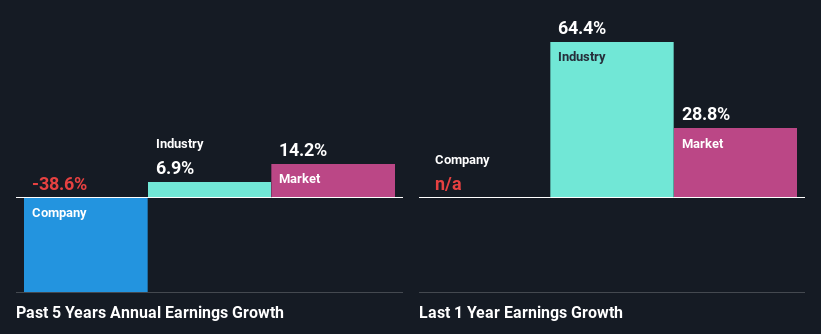Does Insurance Australia Group Limited's (ASX:IAG) Weak Fundamentals Mean That The Stock Could Move In The Opposite Direction?
Most readers would already know that Insurance Australia Group's (ASX:IAG) stock increased by 2.8% over the past month. However, its weak financial performance indicators makes us a bit doubtful if that trend could continue. Specifically, we decided to study Insurance Australia Group's ROE in this article.
ROE or return on equity is a useful tool to assess how effectively a company can generate returns on the investment it received from its shareholders. In other words, it is a profitability ratio which measures the rate of return on the capital provided by the company's shareholders.
See our latest analysis for Insurance Australia Group
How To Calculate Return On Equity?
Return on equity can be calculated by using the formula:
Return on Equity = Net Profit (from continuing operations) ÷ Shareholders' Equity
So, based on the above formula, the ROE for Insurance Australia Group is:
4.6% = AU$297m ÷ AU$6.5b (Based on the trailing twelve months to December 2021).
The 'return' is the yearly profit. That means that for every A$1 worth of shareholders' equity, the company generated A$0.05 in profit.
What Has ROE Got To Do With Earnings Growth?
So far, we've learned that ROE is a measure of a company's profitability. Depending on how much of these profits the company reinvests or "retains", and how effectively it does so, we are then able to assess a company’s earnings growth potential. Assuming all else is equal, companies that have both a higher return on equity and higher profit retention are usually the ones that have a higher growth rate when compared to companies that don't have the same features.
Insurance Australia Group's Earnings Growth And 4.6% ROE
When you first look at it, Insurance Australia Group's ROE doesn't look that attractive. We then compared the company's ROE to the broader industry and were disappointed to see that the ROE is lower than the industry average of 9.9%. For this reason, Insurance Australia Group's five year net income decline of 39% is not surprising given its lower ROE. We believe that there also might be other aspects that are negatively influencing the company's earnings prospects. Such as - low earnings retention or poor allocation of capital.
That being said, we compared Insurance Australia Group's performance with the industry and were concerned when we found that while the company has shrunk its earnings, the industry has grown its earnings at a rate of 6.9% in the same period.
The basis for attaching value to a company is, to a great extent, tied to its earnings growth. What investors need to determine next is if the expected earnings growth, or the lack of it, is already built into the share price. Doing so will help them establish if the stock's future looks promising or ominous. Is IAG fairly valued? This infographic on the company's intrinsic value has everything you need to know.
Is Insurance Australia Group Efficiently Re-investing Its Profits?
With a high three-year median payout ratio of 80% (implying that 20% of the profits are retained), most of Insurance Australia Group's profits are being paid to shareholders, which explains the company's shrinking earnings. With only a little being reinvested into the business, earnings growth would obviously be low or non-existent.
In addition, Insurance Australia Group has been paying dividends over a period of at least ten years suggesting that keeping up dividend payments is way more important to the management even if it comes at the cost of business growth. Our latest analyst data shows that the future payout ratio of the company over the next three years is expected to be approximately 78%. Regardless, the future ROE for Insurance Australia Group is predicted to rise to 12% despite there being not much change expected in its payout ratio.
Summary
Overall, we would be extremely cautious before making any decision on Insurance Australia Group. As a result of its low ROE and lack of much reinvestment into the business, the company has seen a disappointing earnings growth rate. That being so, the latest industry analyst forecasts show that the analysts are expecting to see a huge improvement in the company's earnings growth rate. To know more about the latest analysts predictions for the company, check out this visualization of analyst forecasts for the company.
Have feedback on this article? Concerned about the content? Get in touch with us directly. Alternatively, email editorial-team (at) simplywallst.com.
This article by Simply Wall St is general in nature. We provide commentary based on historical data and analyst forecasts only using an unbiased methodology and our articles are not intended to be financial advice. It does not constitute a recommendation to buy or sell any stock, and does not take account of your objectives, or your financial situation. We aim to bring you long-term focused analysis driven by fundamental data. Note that our analysis may not factor in the latest price-sensitive company announcements or qualitative material. Simply Wall St has no position in any stocks mentioned.

 Yahoo Finance
Yahoo Finance 
